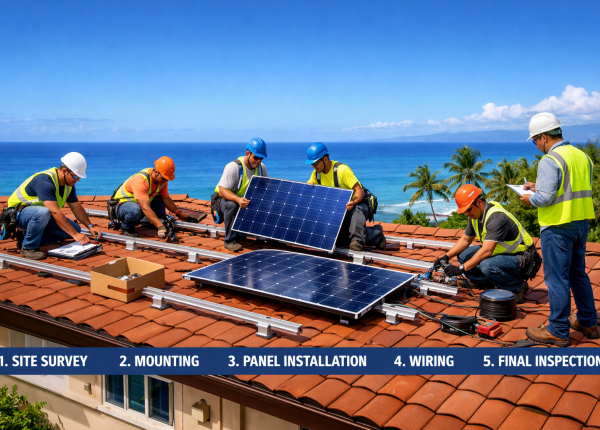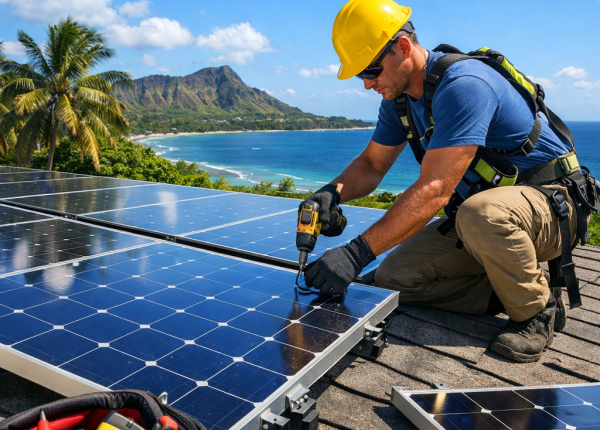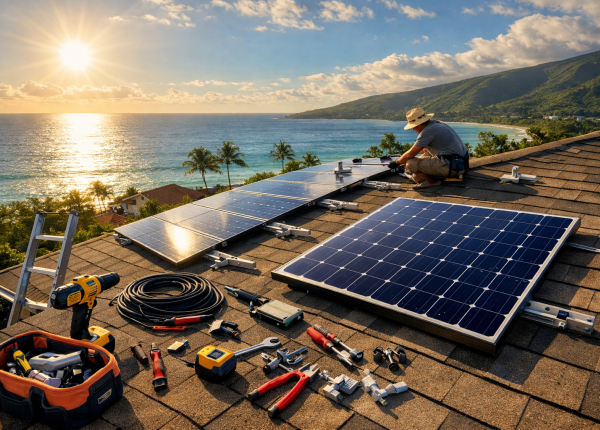Solar Energy Myths and Facts: Understanding the Truth About Solar Power
Ever wondered why some people hesitate to go solar, even when Hawaii enjoys abundant sunshine all year? Misconceptions and outdated beliefs about solar power have kept many homeowners from embracing one of the most sustainable energy solutions available. Maybe you’ve heard claims like “solar panels don’t work on cloudy days” or “solar is too expensive.” These are just a few of the many solar energy myths still circulating today.
In this guide, we’ll clear the air by debunking solar energy myths and replacing them with science-backed facts. Whether you’re considering rooftop panels, storage solutions, or energy-efficient upgrades, understanding the truth can help you make confident decisions that save money and reduce your carbon footprint.
By the end, you’ll know:
- Which myths about solar energy hold people back.
- The real solar energy facts that prove its value.
- How solar performs in Hawaii’s tropical environment.
Let’s dive in and uncover the facts.
Why Understanding Solar Energy Myths Matters in Hawaii
Solar energy is central to Hawaii’s renewable future. With its unique geography and ambitious sustainability goals, Hawaii has the potential to lead the nation in clean energy production. Yet, misinformation often causes hesitation among homeowners and businesses.
Here’s why debunking solar myths matters:
- Reduces confusion about installation, maintenance, and cost.
- Encourages adoption of clean, renewable energy technologies.
- Supports Hawaii’s 100% renewable energy goal by 2045.
- Empowers consumers with factual, reliable knowledge.
When people understand how solar truly works, they gain the confidence to invest in long-term energy independence. Unfortunately, many misconceptions stem from outdated information or misinterpreting how solar interacts with the local power grid.
Let’s separate solar energy myths and facts once and for all.
Top Solar Energy Myths and Facts You Need to Know
Below are the most common solar panel myths—and the truth behind each one.
Myth 1: Solar panels don’t work on cloudy or rainy days
Fact: Solar panels continue generating power even when the sun isn’t shining directly. They capture diffuse sunlight, which still produces electricity during cloudy or rainy days.
Germany, despite having far fewer sunny days than Hawaii, remains a global leader in solar energy production.
Pro Tip: Choose high-quality photovoltaic panels optimized for Hawaii’s tropical climate to ensure consistent performance year-round.
Myth 2: Solar power is too expensive for most homeowners
Fact: This is one of the most common renewable energy myths. The cost of solar has dropped more than 70% over the last decade. Combined with Hawaii’s federal and state incentives, solar power is more affordable than ever.
Example: With the 30% federal Investment Tax Credit (ITC) and Hawaii’s local incentives, you can significantly reduce upfront installation costs.
Pro Tip: Explore PV storage solutions to maximize savings and energy independence.
Myth 3: Solar panels require constant maintenance
Fact: Modern solar panels are built for durability and require minimal upkeep. Other than occasional cleaning to remove dust or salt buildup, panels operate efficiently for decades.
Pro Tip: Schedule an annual inspection with your installer to ensure peak performance and catch minor issues early.
Myth 4: Solar panels damage your roof
Fact: Professional installation actually protects your roof. Mounting systems are designed to prevent leaks and distribute weight safely. In many cases, panels even extend roof lifespan by shielding it from direct sunlight.
Pro Tip: Partner with experts who also provide roofing services for seamless, secure installation.
Myth 5: Solar panels don’t last long
Fact: Most panels come with 25–30-year warranties and continue producing energy well beyond that. Many still generate over 80% of their original output after three decades.
This extended solar panels lifespan makes solar one of the most reliable renewable technologies available today.
Myth 6: Solar energy only works with battery storage
Fact: Batteries are optional. Grid-tied systems work perfectly without them, allowing you to send excess energy back to the grid for credit through net metering or similar programs.
Pro Tip: Consider electric vehicle charging or battery storage for added energy flexibility.
Myth 7: Solar won’t save much money in Hawaii
Fact: Hawaii has some of the highest utility rates in the nation, which means solar savings are greater here than almost anywhere else. A properly sized system can cut electric bills by 60–90%.
Pro Tip: Pair your solar setup with energy-efficient air conditioning to reduce consumption even further.
Myth 8: Solar panels look unattractive
Fact: Modern solar panels are sleek, low-profile, and designed to blend with your roofline. Many homeowners find they actually enhance curb appeal and boost property value.
Myth 9: Solar power isn’t reliable
Fact: When professionally installed, solar energy is extremely dependable. Systems with storage maintain power even during grid outages or natural disasters—something crucial in island communities.
Pro Tip: Pair panels with solar water heating or backup storage for maximum energy resilience.
Myth 10: Solar energy isn’t truly eco-friendly
Fact: While manufacturing panels requires some energy, the environmental benefits vastly outweigh the costs. Over their lifetime, solar panels offset 20–30 times the energy used to produce them.
Sources like Energy.gov and NREL confirm solar power’s small carbon footprint compared to fossil fuels.
How Solar Energy Myths Impact Real Decisions
Misinformation discourages families and businesses from switching to clean power, delaying both personal and statewide benefits.
Here’s how myths affect decisions:
- Homeowners postpone installations due to perceived costs.
- Businesses miss opportunities for long-term savings.
- Hawaii’s progress toward 100% renewable energy slows.
The truth is, every solar installation strengthens energy independence and reduces reliance on imported oil.
Real-World Examples of Solar Success in Hawaii
Residential: A Maui family installed a 6 kW rooftop system covering 85% of their annual electricity use—saving over $1,500 per year.
Commercial: A Honolulu hotel added solar panels and cut its energy costs by 40%, recovering installation costs within five years.
Community: Kauai’s solar-plus-storage projects now generate nearly 70% of the island’s daytime power, setting an example for other states.
Each story proves the same point: when myths give way to facts, everyone benefits.
Tips to Get the Most from Your Solar Investment
Maximize performance and savings with these best practices:
- Work with trusted local experts: Choose a certified Hawaii installer familiar with island conditions.
- Use available incentives: Take advantage of federal and state tax credits while they last.
- Monitor your system: Many solar systems include performance apps to track energy generation daily.
- Maintain regularly: Keep panels free from shade or debris to ensure maximum efficiency.
- Add storage strategically: Consider battery backup for resilience during outages.
Visit Alternate Energy Hawaii for personalized solutions including solar panels, batteries, and efficient home systems.
Embrace Solar Energy with Confidence
The myths and facts about solar energy show that solar isn’t just possible—it’s practical, affordable, and a cornerstone of Hawaii’s sustainable future.
By understanding the truth behind solar energy myths, you empower yourself to make smart, eco-conscious choices that lower costs and protect the planet.
Ready to start your solar journey? Explore photovoltaic systems, PV storage solutions, and more with Alternate Energy Hawaii—your trusted partner in clean energy innovation.
Frequently Asked Questions About Solar Energy Myths
1. Is solar energy worth it in Hawaii?
Absolutely. With high electricity rates and consistent sunshine, Hawaii homeowners often see faster payback periods and larger savings than anywhere else in the U.S.
2. How long do solar panels last in Hawaii’s climate?
Most panels last 25–30 years or more. They’re engineered to withstand heat, humidity, and salty air.
3. Do solar panels work during a power outage?
Only systems with batteries provide power during outages. Grid-tied systems automatically shut off for safety until power is restored.
4. Can solar panels increase home value in Hawaii?
Yes. Homes with solar installations typically sell faster and at higher prices due to lower ongoing energy costs.
5. Are there government incentives for solar in Hawaii?
Yes. Homeowners can claim a 30% federal tax credit plus Hawaii’s state-level incentives, significantly reducing installation costs.


